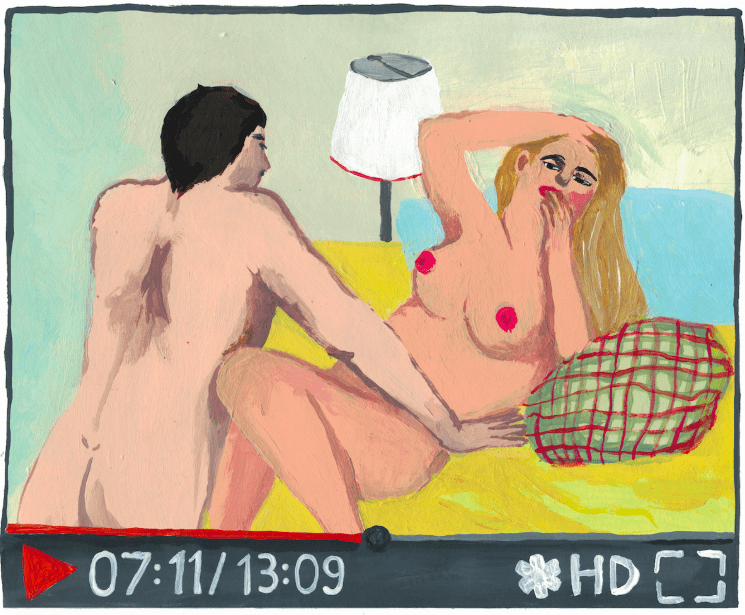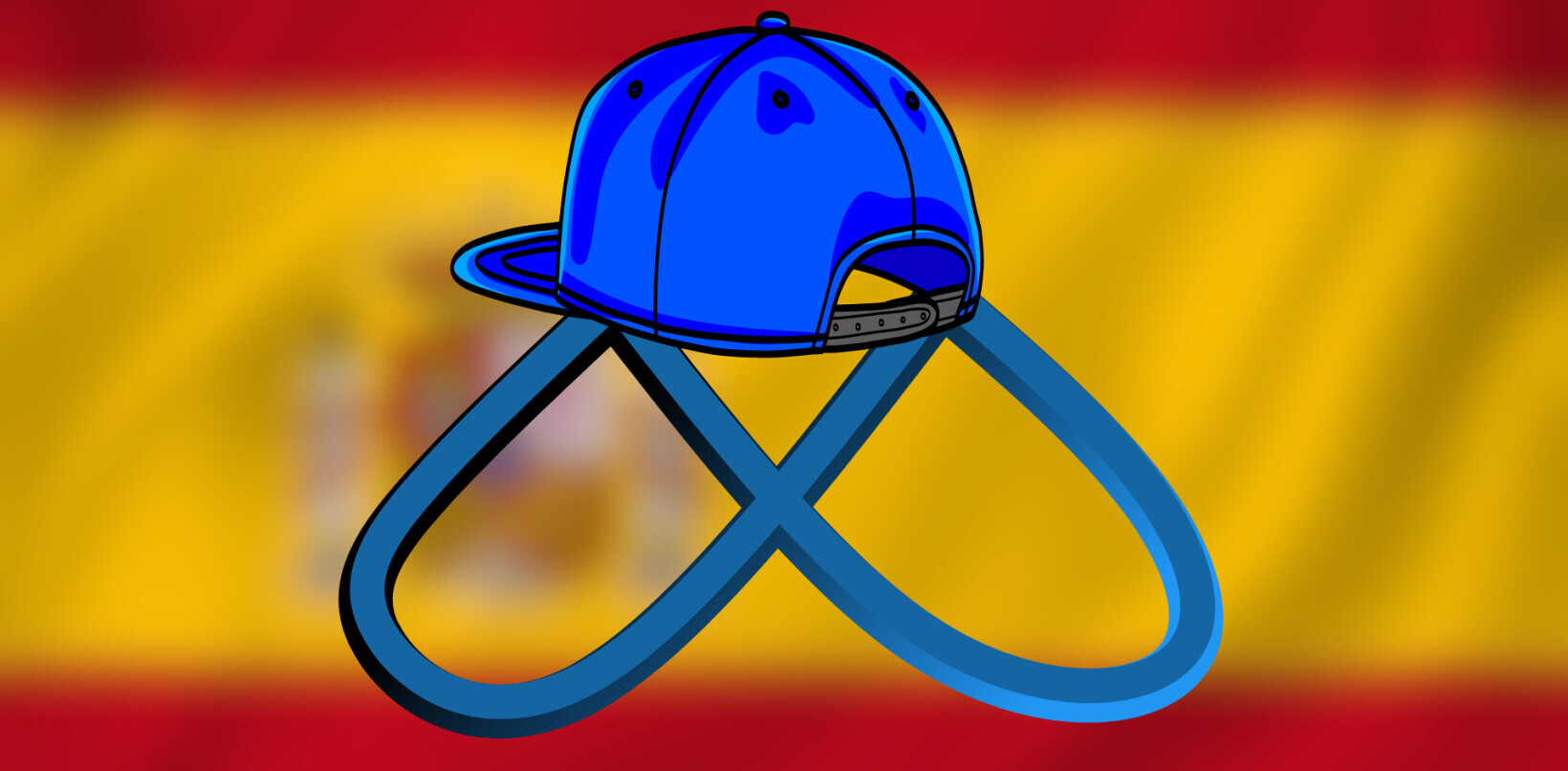
Did you know TNW Conference has a track fully dedicated to exploring new design trends this year? Check out the full ‘Sprint‘ program here.
I’m looking at porn with a woman I met on the internet.
To the left of our Skype video chat, a checkerboard of video stills merge into one single disingenuous orgasm. Bodies grind and groan in their windows, holding positions with dexterous ease. As we scroll and browse the various clips, animated porno Gifs bounce irritatingly in the margins of the screen, trying to catch our gaze.
“Pornhub wants us to come here, open up a video, open up another, and lose our afternoon Vegas-style,” says Missy Kelley, the woman I’ve just met. Kelley is a UX and AI product design director who I connected with via email. She’s recently updated the Make Love Not Porn website, the “social sex” video-sharing platform spearheaded by Cindy Gallop and brought into public consciousness after her 2009 TED Talk went viral. I figure Kelley has something to say about the interface design of popular sex sites, which, according to most current web-design lore, are chaotic and poorly designed. “Sites like Pornhub obviously want to monitor our engagement by providing one dopamine hit after another. It’s all about fast consumption and clicks,” says Kelley.
If we side with the popular opinion that minimal, stripped-back interfaces improve user experience, a black background with bright orange Arial and a swirl of animated sidebars advertising lonely, local MILFs is not the stuff effective web design is made of. Yet it’s no coincidence that Pornhub, xTube, RedTube, YouPorn, xVideos, xHamster, and more all feature very similar interfaces. What appears under-designed is in fact highly strategic.
“The question of whether or not a design is ‘good’ always takes me to the question of whether it’s fulfilling its function, which Pornhub seems to be. Sites like it are so immediate,” says Kelley. “From your search results, you know what’s about to happen in a video. But you’re also distracted by the content surrounding your clip, so while you’re watching, you’re also thinking, what’s next? And then you continue to click.”
I skip from a clip of three tanned, hard bodies gyrating against a palm tree to another featuring a butch woman with tattoos and a strap-on winching a woman in UGGs on a marble kitchen counter. Next, I fall down a rabbit hole of clicking: I find porn with body hair, masks, nipple-piercings, stretch marks, balloons, Tasers, cupcakes. Beyond the pencil-thin women with bleached-blonde manes adorning the homepage lies a tour of human sexual diversity, if you know how to find it.
Our culture very rarely talks about what is meant by “porn.” For some, it means certain websites and carefully honed search terms; for others, it’s a vague memory in a dark room at 4 a.m. Some find porn an embarrassing mimicry of “real” sex; others feel enslaved by their desire for it; and many more enjoy watching it as part of a daily or weekly routine, seeing it as a space for fulfillment, relaxation, or discovery.
And while we might not discuss personal browsing habits with one another publicly, that’s not to say that our searches go unobserved. With tens of millions of people visiting mainstream tube sites such as Pornhub, xHamster, and xVideos each year, online porn is part of that same world of algorithms and data mining that drives most profit-making enterprises on the internet. Tube sites have data on what we click on and search for—information they use to predict our desires and feed content back to us.
While you might be heading online for a quick fix, the UX design of a porn site is doing everything in its power to keep you clicking. Like all the data giants, porn tubes are designed to increase “attention retention” and “time on site.” The longer viewers browse, the more data they produce. And the UX design of these sites keeps users clicking by abiding by the age-old rule of desire: The best way to keep someone interested is to keep them guessing.
The design patterns of mainstream porn sites
In consumer culture, variety is the illusion of choice. It instills the belief that you’ll eventually find what you’re looking for. When you browse a store like IKEA, or the shelf of a supermarket, sheer overload implies that somewhere among it all you’ll find exactly what’s right for you.
Amid an abundance of throw pillows you’ll surely find the right color combo to match your curtains; out of the 60 spiced-coconut granola cereal brands, you’ll eventually find the right mix of flavor and crunch. And in browsing and searching, you stay for longer—finding other products along the way. Porn tubes function on this same seductive principle. By giving you so much, almost too much, to look at, you keep clicking and browsing, believing that eventually you’ll find your perfect clip.

“The graphical interfaces of pornographic video streaming sites create a space of dwelling, wandering, browsing, meandering, or prolonging engagement for the purpose of pleasure, or for keeping boredom at bay, idle distraction, and time squandering,” writes information scholar Patrick Keilty in his 2018 essay “Desire by design: pornography as technology industry.” Keilty likens porn tube design to IKEA, with its carefully plotted consumer pathways. He argues that in mining our browsing habits, the online pornography industry mediates sexual categories, and fetishizes racial, class, and cultural differences.
Dissect the user-facing design elements of mainstream porn tubes, and you’ll quickly see a pattern emerge, one that is highly effective for upping attention retention and keeping eyes wandering. All sites include a similarly arranged cacophony of animation, Gifs, live action, typography, logo, sound, page views, and gleaming “like” buttons. Logos always sit on the top left, followed by a thin search bar and a drop-down menu of categories.
Rows and columns of video stills crowd underneath; live action advertisements sit on the right-hand side, which usually feature DTF singles or cartoon animal-women hybrids with impossibly large breasts. I’ve watched vloggers enter pornography sites for the “eye-tracker challenge”—that popular dare where YouTubers install eye tracking technology that follows their eyes on a screen and maps their sorry attempts to avoid looking at sexualized body parts on various websites.
When faced with the swollen, bouncing cleavage in a live-action ad box, vloggers’ eyes dart right towards it. Tube interfaces compel the viewer to take in the entirety of the page: eyes are drawn clockwise, from logo to moving breasts, and then down leftwards, eventually falling on a bottom row of videos ready for perusal.
“These spaces are designed to give viewers routes to follow while distracting them with an abundance of products,” writes Keilty. “In doing so, this mode of design promises satisfaction while delivering unintelligibility and disorientation in order to remove one’s sense of autonomy through capital-productive distractions.”
The pioneer of all ecommerce platforms
The adult industry’s profits have long driven broader technological innovation, with the creation of new sales tactics and revenue streams like live chat, video streaming, secure credit card processing, pop-ups, and web promotions. We see those features on all kinds of sites, but they originated in porn. In the days of the early web, pornography proved to all e-commerce skeptics that consumers were willing to plug their credit card information into impersonal pop-ups.
“The porn industry has served as a model for a variety of online sales mechanisms, including monthly site fees, the provision of extensive free material as a lure to site visitors, and the concept of upselling (selling related services to people once they have joined a site),” writes Frederick S. Lane III in Obscene Profits: The Entrepreneurs of Pornography in the Cyber Age. “In myriad ways, large and small, the porn industry has blazed a commercial path that other industries are hastening to follow.”
Data, on the other hand, first entered porn after the rise of YouTube. By 2007, adult industry entrepreneurs had created numerous imitations of the video sharing service, including RedTube and YouPorn. Soon these sites caught on to the fact that their content-funneling practice (mostly of pirated pornographic films as well as diverse amateur content) had created a massive, sprawling, and very valuable dataset. Funded by ad revenue, the tube sites—as with all streaming services at the time—tapped into their data to draw more users to their site, and for longer periods of time.
It seems surprising that there’s such little objection to the spread of pornography that actively targets and mines its consumers. This may be because we don’t talk about the porn we watched last night with the same openness that we might discuss a recent Facebook thread. Brands, too, push porn out of their orbit (Google, for example, doesn’t allow pornographic content in its results unless a search term is specific enough).
Despite their immense daily traffic, advertisers don’t advertise on porn platforms unless they’re also part of the adult industry. And so we’ve turned a blind eye to the use of our sexual data while railing against the use of our social data. Equally concerning, and rarely discussed, is the fact that one single company is gaining sway over a sizable number of porn’s distribution and production. It’s the same company behind every one of the tube sites I’ve been browsing.
MindGeek’s unassuming website states that the design, development, marketing, and SEO company is “pioneering the future of online traffic”—but it doesn’t say what it actually shares on its nearly 100 websites. MindGeek currently operates many major tubes including Pornhub, RedTube, and YouPorn; it has 10 production companies (including Brazzers and Digital Playground) as well as ties to other major studios.

With MindGeek’s ownership over areas of its content, parts of the adult industry are now in the paradoxical situation of working for a company that makes money from the piracy of its output: When the production company Brazzers shoots a video, for example, it then gets pirated and uploaded onto one of the tubes. “What we have now is an unprecedented centralization, along with the data economy that goes with it,” says Susanna Paasonen, a pornography studies expert and professor in media studies at Finland’s University of Turku. “As a result, it’s increasingly difficult to make a living as an independent pornographer.”
And how precisely does MindGeek monetize all its data? “Well, it provides all kinds of services, and not just for porn,” says Paasonen. “If everything goes according to plan, MindGeek will actually design the UK’s national age verification system. So in a way, MindGeek will make money from blocking access to its adult content in addition to making money for providing that content.”
Keeping the ’90s promise
In the ’90s, it took very little to set up a porn site that could turn a healthy profit. The first to make it were independent entrepreneurs and a range of individuals distributing and producing for various platforms. Porn viewers were able to find niche content if they knew how to search for it—making it easier than ever for people to embrace a diversity of bodies and fetishes, likes and dislikes. To many, the landscape was liberating.
Previously—and for women especially—the pursuit of a broad range of sexual experiences had come with a sense of stigma and danger. But online, in the sprawling intimacy of the world wide web, people could discern and they could learn.
With the rise of the tubes in the 2000s, images, and videos needed to be more searchable, which meant the accumulation of metadata. “As a result, the taxonomy of categories in porn has grown rather diverse,” says Paasonen. “I would say that generally, the increase in the centralization of metadata and the categories that go with that has meant an expansion in terms of what people recognize. A certain porn literacy has come into being.”
Acts that used to be marginal—kink or subcultural—have grown instantly recognizable through online indexing. And the answers that algorithms uncovered continue to assure people of the presence of the like-minded; no one is alone with her abhorrent desire.
“There has been an expansion in realms of possibility in terms of what bodies can do in porn, and I think that’s actually a positive thing because it generates particular kinds of learning,” says Paasonen. “But then, of course, what gets pumped to the surface tends not to be a huge diversity in terms of bodies and genders. In a way, it’s a dual process.” The tubes are a web of contradictions. While they offer visibility to a range of sexual preferences, at the same time they thrive on categories that perpetuate stereotypes and the exotification of ethnic difference.
“As the tube sites are now so massive, they seem to offer that original ’90s promise of catering to every taste,” continues Paasonen. “But then, with the way that algorithms work, what will you actually find when you enter something into the search? There’s not much transparency in terms of what gets pumped up to the surface in the results.”
Increasingly, the content that’s pushed to the top likely reflects what is profitable to MindGeek—say, the content created by the production companies it owns or sponsored content—not necessarily what is always most applicable to you or your search terms. Searching for “butch lesbian,” for example, may result in top hits pushed by MindGeek that don’t really fit the bill, but that doesn’t mean the database is void of content that might.
“The live search results look very, very different from the listings of the most popular terms,” adds Paasonen. While Pornhub does publish yearly reports on its stats, it does so in the name of PR and clickbait; it’s not clear how accurate they actually are. MindGeek is not a listed company, so it does not have to release its data. Indeed, if you search across the entire Pornhub network live-stream, no two searches ever seem the same: at this moment in time, the words “Detective, Two girls bully, Dildo chase, Tight jeans outdoor, Panties, Pantyhose, Electric, Cucumber” flutter past.
According to an interview with a developer at xHamster, it’s by looking at user data collected using Google Analytics that the site determines what videos to put on a homepage’s ‘Most Viewed’ tab. They’re also regularly running a variety of A/B tests—experimenting with different content to find out more about how certain demographics respond. The sites are therefore driven by what is most profitable and what’s deemed most popular.
Given the number of people disabling cookie trackers, using proxy IP addresses to mask location, and logging out of their personal accounts, though, some have pointed out that it’s very likely that the tubes aren’t gathering reliable or accurate data. And in attempting to infer what its users want in order to drive up engagement, the tubes push certain acts and fetishes over others. In doing so, our sexual reference points as well as our desire is mediated by the logic of clickbait.
Pornhub averted my interview requests for this article, though I did eventually get this quote from its head of design, David Rock: “Our ultimate goal is for Pornhub to be considered one of the best sites, not just in the porn arena, but on the entire web.” If we define what is best by that which serves its specific purpose most efficiently, and if we agree that the purpose of a data giant is to create an interface that will distract users in order to mine them, then Pornhub’s ultimate goal is easily within its reach.
This article is excerpted from the fifth issue of Eye on Design magazine. Pick up a copy of Eye on Design’s “Distraction” issue for a deeper dive into how the influx of notifications, screens, and unread emails are shaping the way we think.
This article was originally written by Madeleine Morley for AIGI Eye on Design, a publication covering the world’s most exciting designers—and the issues they care about.
Get the TNW newsletter
Get the most important tech news in your inbox each week.





